112
THE FRIEND OF ALL.
BERRIES.
Berries as a whole:
Popular Meaning................... 112
What a Berry is.................... 112
Blackberries:
Kittatinny......................... 123
Lawton, or New Rochelle.......... 122
New Rochelle, or Lawton.......... 122
Snyder............................. 133
Soil and Culture.................... 125
What they are...................... 122
Wilson‘s Early..................... 123
Cranberries:
Cultivation......................... 129
Cape Cod Culture.................. 130
Description........................ 129
Name, the............ ............. 130
Results............................. 130
Uses................................ 130
Varieties........................... 129
Currants:
Black Currants..................... 127
Cherry-Currant.................... 126
Choice and Preparation of Soil..... 127
Origin of Cultivated Varieties...... 125
Planting........................... 127
Red Dutch......................... 126
Versailles.......................... 127
Victoria............................ 127
White Dutch....................... 126
White Grape...................... 126
Gooseberries:
Cultivation......................... 128
Chester, or American Red......... 128
Description........................ 127
Downing .......................... 128
Foreign Varieties.................. 128
Hobbs’ Seedling................... 128
Houghton Seedling................. 128
Mountain Seedling................. 129
Pale Red........................... 129
Ribes Hirtellum.................... 128
Smith‘s Improved.................. 128
Raspberries:
Belle de Fontenay.................. 121
Black-Caps......................... 122
Brandywine........................ 122
Cuthbert........................... 122
Description......................... 118
Fastollf............................ 119
Franconia....... .................. 119
Hudson River Antwerp............ 119
Knevet‘s Giant..................... 119
Manures............................ 122
Native Red Species................ 118
Propagation........................ 122
Red Antwerp of England.......... 118
Soil and Culture.................... 122
Turner............................. 121
Strawberries:
Bad Planting...................... 116
Black Defiance..................... 115
Strawberries:
Charles Downing.................. 114
Crescent Seedling.................. 115
Description......................... 113
Different Methods of Cultivation... 117
Duchess............................ 115
Fragaria Chilensis.................. 113
Fragaria Virginiana................ 113
Freshening up Roots............... 116
Hill System........................ 117
Hovey’s Seedling.................. 113
Jucunda............................ 115
Manures............................ 118
Matted Bed System................ 117
Monarch of the West............... 114
Mulching.........................117
Narrow Row System............... 117
Neuman‘s Prolific.................. 116
Original Ancestor.................. 113
Origin of the Name................ 118
Planting and Setting...............116
President Wilder................... 115
Runners........................... 117
Seth Boyden........................ 115
Sharpless........................... 115
Shortening Roots.................. 116
Spring Cultivation................ 118
State of the Ground................ 116
Triomphe de Gand................. 115
Watering.......................... 117
Wilson‘s Albany.................... 113
What is a Berry ?— Perhaps the reader imagines
that he (or she—where is that epicene pronoun ?)
knows what a berry is. Listen : “ This term is
employed in botany to designate a description
of fruit more or less fleshy and juicy, and not
opening when ripe. The inner layers of the
pericarp are of a fleshy or succulent texture,
sometimes even consisting of mere cells filled
with juice, whilst the outer layers are harder, and
sometimes even woody. The seeds are immersed
in the pulp. A berry may be one-celled, or it
may be divided into a number of cells or com
partments, which, however, are united together
not merely in the axis, but from the axis to the
rind. It is a very common description of fruit,
and is found in many different natural families,
and both of exogenous and endogenous plants.
As examples may be mentioned the fruits of the
gooseberry, currant, vine, barberry, bilberry, bel
ladonna, arum, bryony, and asparagus, which, al
though agreeing in their structure, possess widely
different properties. Some of them, which are
regarded as more strictly berries, have the calyx
adherent to the ovary, and the placentas—from
which the seeds derive their nourishment—pa
rietal, that is, connected with the rind, as the
gooseberry and currant; others, as the grape,
have the ovary free, and the placentas in the
center of the fruit. The orange, and other fruits
of the same family, having a thick rind dotted
with numerous oil-glands, and quite distinct
from the pulp of the fruit, receive the name hes-
peridium; the fruit of the pomegranate, which is
very peculiar in the manner of its division into
cells, is also sometimes distinguished from berries
of the ordinary structure by the name balausta.
Fruits like that of the water-lily, which at first
contain a juicy pulp, and afterwards, when ripe,
are filled with a dry pith, are sometimes desig
nated berry-capsules. The gourds, also, which
have at first three to five. compartments, but
when ripe generally consist of only one compart
ment, are distinctively designated by the term
pepo, peponium, or pepontda, to which, however,
gourd may be considered equivalent.”
Popular Signification of the Word.—The term berry
is usually applied to several small fruits which
are not berries in the scientific sense, as the
Strawberry, which bears seeds (ackenia) on the
external surface of an enlarged and pulpy recep
tacle. So under the head of Berries in this book
the Strawberry is put; while, per contra, under
another head are placed Grapes, which although
scientifically berries, will be found under Fruit.
Neither grapes nor oranges partake of the ephe
meral and quickly perishable nature characteriz
ing what are in common parlance known as ber
ries.
The cultivation of berries and small fruits has
largely increased within the last few years, and in
berries. 113
most cases where it has been carried on judi
ciously in the vicinity of large markets, or at
remoter points under favorable freighting ar
rangements; the results have generally proved
successful in variety, quality and quantity.
There has been a steadily increasing demand for
this product, and farmers and fruit-growers who
send articles of good quality, and in good condi
tion to market, are sure to be well remunerated.
STRAWBERRIES.
What the Strawberry is.—The first place in any
list of “ berries” undoubtedly belongs to this old
friend. Not a berry proper, it is Fragaria; a
genus of plants of the natural order Rosaceœ, sub
order Roseœ, tribe Potentillzdœ, remarkable for
the manner in which the receptacle increases and
becomes succulent, so as to form what is popu
larly called the fruit; the proper fruit (botanical-
ly) being the small achenia which it bears upon
its surface. The genus differs from Potentilla
chiefly in having the receptacle succulent. The
calyx is 10-cleft, the segments alternately small
er; the petals are five; the style springs from
near the base of the carpel. All the species are
perennial herbaceous plants, throwing out run
ners to form new plants; and the leaves are
generally on long stalks, with three leaflets, deeply
toothed. One South American species has sim
ple leaves. In no genus are the species more
uncertain to which the cultivated kinds are to
be referred.
The Original Ancestor.—The common strawberry,
8
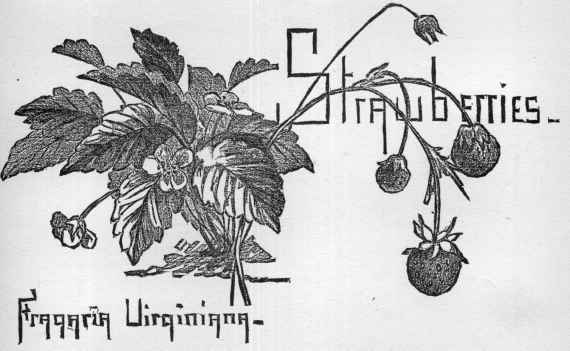
Fragaria Virginiana, which grows wild east of
the Rocky Mountains, is the ancestor of the end
less varieties of this berry, the raising of which
forms today so large an industry in many parts
of the United States.
Another species, called Fragaria Chi/en sis, grow
ing wild along the Pacific coast both in North
and South America, seems to flourish better in
Europe than with us. The European gardeners
are seeking to perfect it, but most of the choice
varieties have not succeeded when imported
here.
The Virginian strawberry is most remarkable
in its capacity for improvement, as all the present
varieties attest.
Hovey’s Seedling.—This great improvement on
the original wild strawberry was introduced in
1834 by C. M. Hovey, of Cambridge, Mass., was
the first precursor of a long line, and is still a
very fine variety. The vines are vigorous and
hardy, producing moderately large crops, and
the fruit is of the largest size and finely flavored.
It is well known all over the country. The leaves
are large, rather light green, and the fruit-stalk
long and erect. Fruit very large, roundish oval
or slightly conical, deep shining scarlet. Seeds
slightly imbedded. Flesh firm, with a rich, agree
able flavor. It ripens about the medium season,
or slightly later.
Wilson’s Albany.—About 1854, John Wilson, of
Albany, N. Y., introduced this variety, which
has since been more generally cultivated than
any other. The vine is very hardy and vigorous,
114 THE FRIEND OF ALL.
very productive, beginning to ripen its fruit early,
and continuing to the latest. Fruit large, broadly
conic, pointed. Color deep crimson. Flesh crim
son, tender, with a brisk acid flavor. In fact, it
is too acid. Mr. Bryant, in the Evening Post, in
1876, gave his opinion: “ Wilson‘s Albany is a
sour, crude berry which is not fully ripe when it
is red, and when perfectly ripe is too acid. When
it first makes its appearance in the market it has
a harsh flavor, and but little of the agreeable
aroma which distinguishes the finer kinds of
the berry. But the Wilson is a hardy berry;
bears transportation well; is exceedingly prolific;
qualities which give it great favor with the cul
tivator, but for which the consumer suffers.
We hope that the Wilsons, as soon as their
place can be supplied with a better berry, will
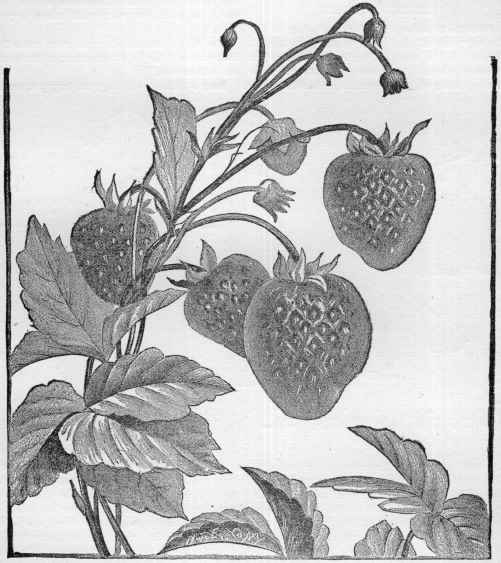
Seth Boyden Strawberry.
be banished from the market,’’ If people do not
demand a better variety, the cultivator will con
tinue to send to market a berry which carries
well, ripens early, and is most prolific.
Charles Downing.—Another variety which grows
well in all parts of the country, introduced by J.
S. Downer, Fairview, Ky. Plant very vigorous
and very productive. Fruit very large, nearly
regular, conical, deep scarlet. Seeds brown and
yellow, rather deep. Flesh quite firm, pink, juicy,
sweet and rich.
Monarch of the West.—This is a very highly
prized strawberry, raised by Jesse Brady, of
Piano, Ill. Plant vigorous, with large, pale
green leaves, moderately productive; a good va
riety for home use and a near market; requires
high cultivation and rich soil to produce large
BERRIES.
115
fruit abundantly and of good quality: should be
grown in hills or narrow rows. Fruit large,
sometimes very large, roundish conical, nearly
regular; a few of the early berries are coxcomb-
shape, and a little irregular; light scarlet; flesh
light red, rather soft, juicy, sprightly subacid,
rich: quality very good.
Seth Boyden.—(Newark, N. J.) Mr. H. Jerola-
man, of Hilton, N. J., writes in 1877 : “My yield
from one acre, planted chiefly with the Seth Boy-
den, was 327 bushels 15½ quarts, which were sold
for $1,386.21. A strict account was kept. Since
that time, I have been experimenting with Mr.
Durand‘s large berries, and have not done so
well. In 1878, I obtained $1181 from one acre,
one half planted with the Seth Boyden and the
Other with the Great American. The year of
1879 was my poorest. Nearly all my plants were
Great American and Beauty, and the yield was
121 bushels, selling for $728. The average cost
per acre, for growing, picking, marketing and
manure, is $350. I am not satisfied but that I
shall have to return to the old Seth Boyden in
order to keep taking the first State premiums, as
I have done for the past three years.”
Sharpless.—This large, showy strawberry ori
ginated with J. H. Sharpless, of Catawissa, Pa.;
very vigorous, with large dark green, coarsely
serrated and deeply veined leaves; very pro
ductive, and is best adapted to the hill system,
making large stools ; it also succeeds in narrow
rows. Fruit large to very large, variable in form,
from irregular coxcomb-shape to roundish coni
cal and oval; bright scarlet, somewhat glossy;
flesh light red, quite firm, moderately juicy, sweet,
rich and of very good flavor; medium to late in
ripening. Very promising, either for market or
family purposes.
Duchess.—This excellent early strawberry ori
ginated in the garden of D. H. Barnes, Pough-
keepsie, N. Y. Very vigorous, foliage of medium
size, dark green and healthy. Very productive ;
when grown in hills or narrow rows it stools and
makes large plants, thus saving the labor of re
planting. Fruit medium to large, roundish,
obtuse conical, regular in form, bright scarlet
or crimson; flesh light red, quite firm, juicy,
sprightly subacid, and of fine quality; one of the
earliest to ripen, and continues a long time for
an early variety; retains its size quite well to the
last; is valuable for early market, and also for
general use in the family. Dr. Thurber, of
the American Agriculturist, unhesitatingly pro
nounced this the best of fifty varieties in one of
Mr. Roe's specimen-beds.
Black Defiance.—One of the seedlings of E. W.
Durand, Irvington, N. J. Plant vigorous, with
dark green foliage, productive in heavy soils ;
requiring high culture in hills or narrow rows,
and removal of runners to obtain the fruit in
quantity and perfection. Fruit large, roundish,
obtuse conical, regular; color dark crimson;
flesh dark red, firm, juicy, sprightly and rich;
rather early, fine for the amateur, and seems a
good variety for shipment to an early market.
Triomphe de Gand.—A Belgian variety, which
appears to stand our climate, and produce more
crops in more localities than any other foreign
sort. The vines are vigorous, hardy, moderately
productive, and well suited to strong, clayey
soils, requiring high cultivation, and to be grown
in hills. Fruit large, roundish obtuse, sometimes
coxcomb-shape, bright rich red near the calyx,
almost greenish white at point, glossy as if var
nished ; seeds light yellow-brown, near surface;
flesh firm, white, a little hollow at core, juicy,
with a peculiar rich and agreeable flavor.
President Wilder.—Raised in 1860 by Hon. M.
P. Wilder, of Dorchester, Mass., from seed of
Hovey‘s Seedling, impregnated with La Con
stante Plant healthy, hardy, vigorous and very
productive. Fruit-stalk short, stout, erect.
Stands the heat of summer and cold of winter
uninjured. Fruit large to very large, roundish,
obtuse - conical, very regular, bright crimson-
scarlet. Seeds mostly yellow, near the surface.
Flesh very white, quite firm, juicy, sweet and
rich. Roe calls this “ President Wilder‘s superb
seedling.”
Crescent Seedling. — Originated with William
Parmelee, New Haven, Conn. Hardy, strong,
a vigorous grower and very productive. Leaves
of medium size, dark green; requires much
room to give good results ; ripens early and con
tinues late, holding its size tolerably well, and
although not of high flavor, its fair size, good
color and moderately firm flesh have given it a
near-market value. Fruit medium to large,
roundish conical, the first berries a little irreg
ular or uneven, bright scarlet; seeds yellow and
brown, near the surfaces. Requires less time and
attention than most varieties, and is well calcu
lated for those who cannot and will not give the
necessary labor to produce the better kinds.
Roe says it renders the laziest man in the land,
who has no strawberries, without excuse. One
of his beds yielded at the rate of 346 bushels to
the acre.
Jucunda.—A foreign variety, that, like some
others of its class, does extremely well in a few
localities under high cultivation. Plant moder
ately vigorous. Fruit large to very large, obtuse-
conical or coxcomb-flattened, bright light scar
let. Seeds mostly yellow. Flesh light pink,
moderately firm, sweet, not high flavor, often
hollow. So says Downing. Roe says: “ The
Jucunda is one of the most superb berries in ex
istence, and can be grown with great profit in
116 THE FRIEND OF ALL.
many localities. . . . During the past summer,
I had upon my wettest and stiffest land two
beds of Jucunda strawberries that yielded at the
rate of 190 bushels to the acre. The Jucunda
strawberry is especially adapted to heavy land
requiring drainage, and I think an enterprising
man in the vicinity of New York might so unite
them as to make a fortune.”
Neuman's Prolific, or the Charleston Berry, is the
great staple in the South, and the chief variety
for shipping. “ It is an aromatic berry, and
very attractive as it appears in our markets in
March and April, but is even harder and sourer
than any unripe Wilson. When fully matured
on the vine, it is grateful to those who like an
acid berry. Scarcely any other kind is planted
around Charleston and Savannah.”—Roe.
Planting and Setting.—Good plants deserve and
will repay careful setting and care. There is
some very favorable weather in early spring, in
which a plant is almost certain to grow even if
carelessly set out, but even then it does better
if properly treated. It is almost as easy to set
out a plant correctly as incorrectly. Excavate
a place large enough and deep enough to take
in the roots, expanded fan-like, their whole
length and circumference. Take the plant in
one hand, and with the other half fill the hole
with rich fine earth, and press it firmly against
the roots; then fill it evenly, and with both
hands press your weight on the soil all around
the plant, till the point from which the leaves
start is even with the ground. The plant must
be in the ground too firm to be lifted by the
leaves. Roe says : “ If a man uses brain and eye,
he can learn to work very rapidly. By one dex
terous movement, he scoops the excavation with
a trowel. By a second movement, he makes
the earth firm against the lower half of the
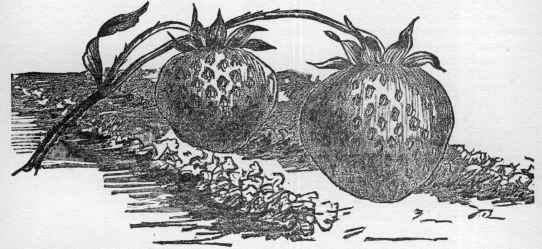
Jucunda Strawberry.
roots. By a third movement, he fills the exca
vation and settles the plant into its final posi
tion. One workman will often plant twice as
many as another, and not work any harder.
Negro women at Norfolk, Va., paid at fifty cents
per day, will often set two or three thousand.
Many Northern laborers, who ask more than
twice that sum, will not set half as many plants.
I have been told of one man who could set 1000
per hour. I should examine his work carefully,
however, in the fear that it was not well done.”
Bad Planting.—On the opposite page are three
illustrations of “ how not to do it.” In the first,
the plant is smothered and stifled by being set
too deep in the earth. In the second and third,
the roots are not given the chance for life they
need. All these might have been set out pro
perly in no more time than was taken to set
them out improperly.
State of the Ground.—This should be made as
nearly level as possible, and equally removed
from a dry lumpy condition, and from one
where the water will not readily drain off. Plant
in moist, freshly stirred earth, and never when
the ground is wet and sticky, unless at the be
ginning of what threatens to be a long storm.
Shortening Roots.—In the spring, roots should
be shortened one third, which excites a rapid
growth of new rootlets, and consequently of the
plants. But later in the season, the plants not
having such an abundance of roots, it is best not
to cut them.
Freshening up Roots.—Sometimes, in along jour
ney, roots get black and sour, and perhaps
moldy. In such case, wash them in clean tepid
water, trim carefully, removing the darkened,
withered ends, set out the plant, treat it with a
little bone-meal, and water it. In warm weather
keep the ground moist till rain comes.
BERRIES.
117
Watering.—The ground should be kept moist
continually, day and night. Give the plant
what it needs till it is able to take care of itself.
Shade it if necessary. The conditions of its
healthy life are coolness, shade and moisture.
Different Methods of Cultivation.—One well-known
plan is the Matted-bed system. The ground be
tween the rows is cultivated and kept clean
during spring and early summer. But the fast-
increasing runners prevent thorough cultivation,
and by winter the entire ground is covered with
plants, and in that condition mulched. In the
spring, the coarsest of the covering is raked
off, and a path made between the rows, to be
afterwards used by the pickers. Under this sys
tem the first crop is usually the best, but the
land often becomes so foul that it does not pay
to keep up the beds the second year. Often two
crops are taken, and then some other crop
alternated before going back to strawberries.
This system sometimes produces fair results, but
is untrustworthy and slovenly. Under it the
farmer has berries a few days where he should
have a few weeks, and his entire crop ripens at
once, perhaps in an overstocked market. It is
no method for a garden, as the hoe and fork
cannot be used among plants sodded together.
There are some modifications of the system, but
they all seem unsatisfactory and slovenly.
Another plan of cultivation is the Hill system.
In this the plants are set out say three feet
apart, and treated like hills of corn, except that
the ground should be level. They are often so
arranged that the cultivator can pass between
them each way. But there are grave objections
to this method. A great deal of ground is wasted,
and the white grub has a chance to do his de
structive work. The labor of mulching, where
so much of the ground is unoccupied, is great.
In small garden-plots this system often works
well. There is opportunity to eradicate weeds,
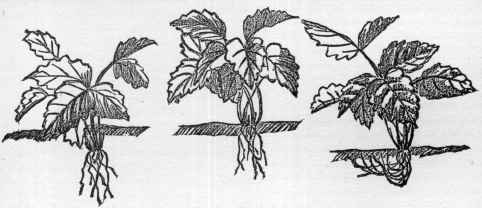
" How not to do it."
to keep the soil mellow and open, and so moist,
and the plants make great bushy crowns, cover
ing the whole space. In the South, this seems
the best system. There the plants are set in the
summer and autumn, and the crop is taken from
them the next spring. The plants are there set
only one foot apart in the rows, and the runners
can be kept down, and each separate plant stimu
lated to do its best.
The third plan of cultivation is the Narrow-row
system, in which the plants are set one foot from
each other in line, and in rows two and a half or
three feet apart, and are not allowed to make
runners. In a good soil they will touch each
other, and make a continuous row, after a year‘s
growth. Between the rows the cultivator can
be carefully run, and the plants from the rows
kept clear of weeds by hand and a small fork.
The ground is thus occupied to the utmost
profitable extent, the berries have access to air
and light, and the beds can be readily mulched.
If necessary, the ground can be easily irrigated,
and the white grub extirpated.
Runners.—Each plant strives to propagate itself;
but if allowed to do so, and in the degree to
which it is allowed, it lessens its own vitality
and power to produce berries the following
season. Remove the runners, and the life of the
plant is concentrated on foliage and fruit. Such
a plant has abounding life, works evenly and
steadily, and perfects its last berry. Rows under
this system have been in bearing seven weeks.
Unless plants are very strong, and set out very
early, fruiting the same year is always dangerous
and often fatal. If berries are wanted in a year,
the plants should be set out in summer or
autumn.
Mulching.—As freezing weather comes on, plants
should be protected with leaves or straw, or
light strawy horse-manure, sufficiently fer
mented to kill the grass-seeds. The plants must
118 THE FRIEND OF ALL.
not be smothered, and yet must be protected.
Watch them during the winter, recover where
washed away, and drain off all puddles. As the
weather softens in early spring begin to push
back the covering, and let in air.
Spring Cultivation.—Edward P. Roe, in his inter
esting and instructive Success with Small Fruits,
recommends “spring cultivation, if done pro
perly and sufficiently early. Even where the soil
has been left mellow by fall cultivation, the beat
ing rains and the weight of melting snows pack
the earth. All loamy land settles and tends to
grow hard after the frost leaves it. While the
mulch checks this tendency, it cannot wholly
prevent it. As a matter of fact, the spaces
between the rows are seldom thoroughly loosened
late in the fall. The mulch too often is scat
tered over a comparatively hard surface, which
by the following June has become so solid as to
suffer disastrously from drought in a blossom
ing and bearing season. I have seen well-
mulched fields with their plants faltering and
wilting, unable to mature the crop because the
ground had become so hard that an ordinary
shower could make but little impression. More
over, even if kept moist by the mulch, land long
shielded from sun and air tends to become sour,
heavy, and devoid of that life which gives
vitality and vigor to the plant. The winter
mulch need not be laboriously raked from the
garden-bed field, and then carted back again.
Begin on one side of a plantation and rake
toward the other, until three or four rows and
the spaces between them are bare; then fork the
spaces or run the cultivator—often the subsoil
plow—deeply through them, and then immedi
ately, before the moist, newly made surface
dries, rake the winter mulch back into its place
as a summer mulch. Then take another strip
and treat it in like manner, until the generous
impulse of spring air and sunshine has been
given to the soil of the entire plantation.”
Manures.—The same author writes : “ Never
seek to stimulate with plaster or lime, directly.
Other plants’ meat is the strawberry's poison in
respect to the immediate action of these two
agents. Horse-manure composted with muck,
vegetable mold, wood-ashes, bone-meal, and, best
of all, the product of the cow-stable, if thoroughly
decayed and incorporated with the soil, will
probably give the largest strawberries that can be
grown, if steady moisture, but not wetness, is
maintained.”
Origin of the Name.—Mr. Roe again : “ If there
were as much doubt about a crop of this fruit
as concerning the origin of its name, the out
look would be dismal indeed. In old Saxon, the
word was streawberige, or streowberrie; and was
so named, says one authority, ‘from the straw-
like stems of the plant, or from the berries lying
strewn upon the ground.’ Another authority
tells us : ‘It is an old English practice’ (let us
hope a modern one also) ‘to lay straw between
the rows to preserve the fruit from rotting on
the wet ground, from which the name has been
supposed to be derived ; although more probably
it is from the wandering habit of the plant, straw
being a corruption of the Anglo-Saxon strœ,
from which we have the English verb stray.’
Again, tradition asserts that in the olden times
children strung the berries on straws for sale,
and hence the name. Several other causes have
been suggested, but I forbear. I have never
known, however, a person to decline the fruit on
the ground of this obscurity and doubt.” John-
son‘s Cyclopedia less poetically reads, “and re
quire in winter a covering of straw, whence the
name.”
RASPBERRIES.
What the Raspberry is.—Rubus Idœus, the most
valued of all the species Rubus. It has pinnate
leaves, with five or three leaflets, which are white
and very downy beneath; stems nearly erect,
downy, and covered with very numerous small
weak prickles ; drooping flowers, and erect whit
ish petals as long as the calyx. The wild rasp
berry has scarlet fruit. It is a low deciduous
shrub, originating from the Mount Ida bramble,
which appears to have reached the gardens of
Southern Europe from Mount Ida. “ It has a
perennial root, producing biennial woody stems
that reach a height of from three to six feet.
The stems do not usually bear until the second
year, and only that year, and are replaced by
new growth from the root. The flowers are
white or red, very unobtrusive, and rich in sweet
ness. Bees forsake all other flowers while rasp
berry blossoms last.
Native Red Species.—Prof. Gray thus describes
this species : “ R. Strigosus, Wild Red R. Com
mon, especially North; from two to three feet
high; the upright stems, stalks, etc., beset with
copious bristles, and some of them becoming
weak prickles, also glandular; leaflets oblong-
ovate, pointed, cut-serrate, white downy be
neath, the lateral ones (either one or two pairs)
not stalked ; petals as long as the sepals ; fruit
light red, tender and watery, but high-flavored,
ripening all summer.”
Red Antwerp of England.—This is the best known
of the imported varieties. Canes strong and tall.
Spines light red, rather numerous and pretty
strong. Fruit large, nearly globular or obtuse-
conical. Color dark red, with large grains, and
covered with a thick bloom. Flesh juicy, with
a brisk vinous flavor. Few old-fashioned gar
dens were without this berry, but it is giving
BERRIES. ‘ 119
way to newer and more popular varieties. The
fruit is too soft for market, but makes a dainty
dish for home use for those who still cultivate it.
The Hudson River Antwerp is the most cultivated
foreign berry in America, quite distinct from the
above, though belonging to the same family. Its
firmness of flesh, and parting readily from the
germ, together with its productiveness, render it
the most popular variety for market. Canes
short, but of sturdy growth, almost spineless,’ of
a very peculiar gray or mouse-color. Fruit
large, conical. Flesh firm, rather dull red, with
a slight bloom, not very juicy, but of a pleasant,
sweet flavor. Said to have been brought to this
country by the late Mr. Briggs, of Poughkeepsie,
N. Y., to whom it was given by a friend, since he
was leaving the country and could not interfere
with its sale in Europe. The owner had refused
three guineas for a single plant. But the variety
for some hidden reason has not flourished except
in a small area on the Hudson River, in Milton
and a little north and south of it. And now a
disease called the “ curl-leaf " threatens its extinc
tion even there. In its prime the line of wagons
at Marlboro landing was often nearly a mile long,
and it is estimated that in a single season
1,ooo,ooo pint baskets, about 14,700 bushels, were
shipped from that landing. But now, Ichabod !
its glory has departed.
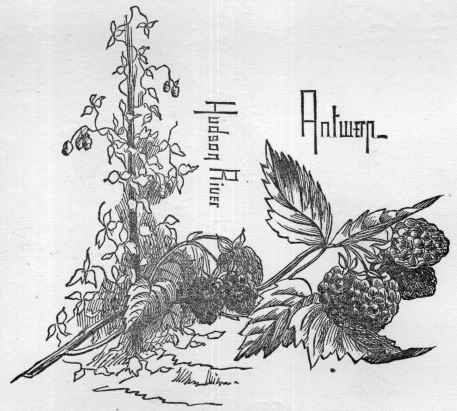
The Fastollf is an English variety of high repu
tation. It derives its name from having origina
ted near the ruins of an old castle, so called, in
Great Yarmouth. Canes strong, rather erect,
branching, light yellowish brown, with few pretty
strong bristles. Fruit very large, obtuse or round
ish conical, bright purplish red, rich and high-
flavored, slightly adhering to the germ in pick
ing.
Knevet‘s Giant.—This is one of the strongest
growing varieties, very productive, and of excel
lent flavor. Canes strong, erect. Spines small,
reddish, very few. Fruit of the largest size, ob
tuse-conical, deep red, firm in texture, and hangs
a little to the germ in picking. Berries some
times double, giving them a coxcomb appear
ance.
The Franconia is now the best foreign variety
we have. It was introduced from Paris, more
than thirty years ago. Its crops are abundant,
the fruit is firm, and bears carriage to market
well, and ripens about a week later than Red
Antwerp. It is one of the finest for preserving.
Canes strong, spreading, branching, yellowish
brown, with scattered, rather stout purple spines.
Leaves rather large, very deep green. Fruit
large, obtuse-conical, dark purplish red, of a rich
acid flavor, much more tart and brisk than that
of the Red Antwerp. Its long continuance in
120 THE FRIEND OF ALL.
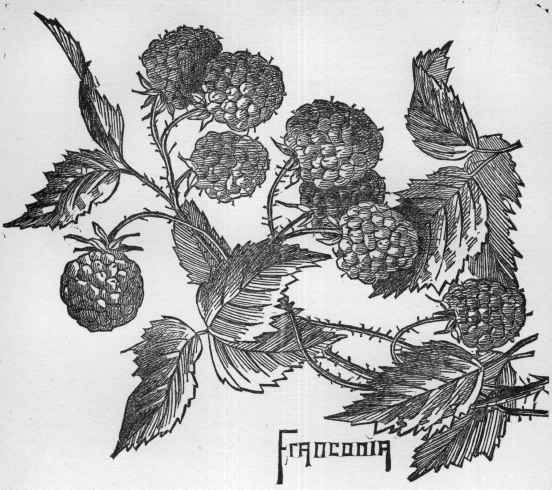
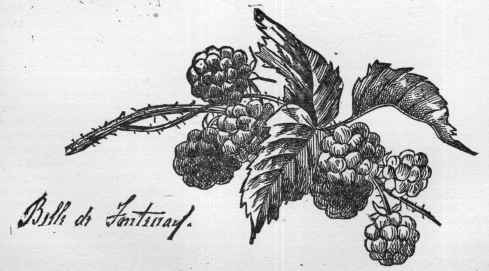
BERRIES. 121
bearing is one of its best qualities, as it lasts six
weeks. It is hardy, and well adapted to high
latitudes.
Belle de Fontenay.—This variety produces its
fruit mainly in the autumn. Suckers freely, and
requires to be carefully thinned out. The canes
should all be cut down in the spring in order to
obtain good crops. Canes strong, stout, branch
ing. Spines purplish, short and stiff, quite nu
merous. Fruit large, long, conical. Grains
large, dark crimson, thin bloom. Flesh moder
ately firm, juicy, sprightly; adheres slightly to
the core. It is said to be entirely hardy, and
to survive the winter without protection a hun
dred miles north of New York. Roe says: “ Its
most marked characteristic is a second crop in
autumn, produced on the tips of the new canes.
If the canes of the previous year are cut even with
the ground early in spring, the new growth gives
a very abundant autumn crop of berries, which,
although much inclined to crumble in picking,
have still the rare flavor of a delicious fruit long
out of season. It certainly is the best of the fall-
bearing kinds, and deserves a place in every gar
den. There are more profitable market varieties,
however; but if the suckers are vigorously de
stroyed, and the bearing canes cut well back, the
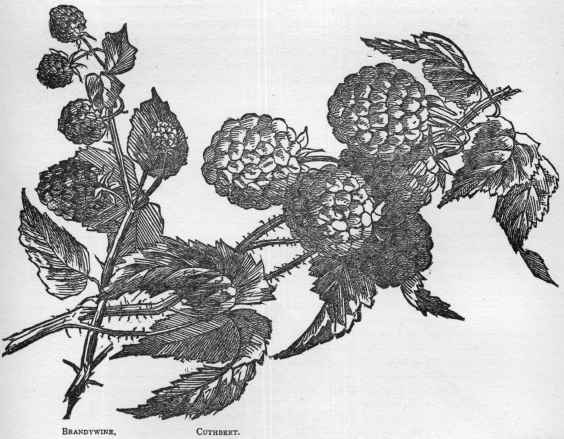
fruit is often very large, abundant and attractive,
bringing the highest prices.”
But the R. Strigosus, our native species, is
scattered almost everywhere throughout the
North, growing wild by hedges and walls, in
forest-glades and in the open fields. Especially
where land has been cleared up and left does this
berry spring up and cover acres and miles. Oc
casionally a bush is found whose fine fruit causes
its transfer to a garden, and a new variety is thus
introduced.
The Turner.—This is a hardy variety origina
ting in the garden of Prof. J. B. Turner, Jack
sonville, Fla.; it appears to succeed in more lo
calities than any of the red varieties, and is less
subject to changes in temperature; the canes,
foliage and fruit possess many characteristics of
the native red berry, and it suckers quite as
freely; canes vigorous, light reddish on the
sunny side; upright, seldom with branches; very
few short, purplish spines; foliage quite large
and abundant; very productive. Fruit medium
or above, roundish conical, bright scarlet; grains
of medium size, compact; flesh rather soft, sweet,
pleasant, but not rich. A good berry for home
use, but not quite firm enough for a distant mar
ket. Roe regards it as the hardiest raspberry in
122 THE FRIEND OF ALL.
cultivation, and says that a winter must be se
vere indeed that injures it.
The Brandywine.—This berry has been widely
popular, its origin being unknown. It became
the principal raspberry grown along the Brandy-
wine Creek, and took among the marketmen the
name of its chief haunt, which it still bears.
Its bright color, good size and its firmness and
great carrying qualities lead to its ready sale, but
its dry texture and insipid flavor are against it,
and it is giving place to
The Cuthbert—This is a chance seedling, ori
ginating in the garden of the late Thomas Cuth-
bert, of Riverdale, N. Y. Quite hardy; a valua
ble market variety, and one of the best for family
use ; very productive ; canes strong, vigorous, up
right, sometimes branching; spines short, stout,
purplish, rather numerous ; suckers freely, rather
too much so. Fruit medium to large, scarlet-
crimson, roundish, obtuse-conical; grains rather
small, compact, separate freely from the stalk ;
flesh quite firm, juicy, sweet, sprightly, having a
slight flavor of the common Red, which is pro
bably one of its parents.
Black-Caps.—This family is now numerous, of
large size and good quality. Prominent are the
Gregg, the Mammoth Cluster, Sweet Home, Sur
prise, Elsie, Davidson s Thornless, Doolittle, etc.
The Gregg was found in 1866 growing wild in a
ravine on the Gregg farm, Ohio Co., Ia. Its
owners claim that it survives the coldest winters,
and has never failed to produce an abundant
crop. It is a vigorous, rapid grower, producing
strong, well-matured canes by fall. The fruit is
beautiful in appearance, and delicious, possessing
excellent shipping and keeping qualities.
Soil and Culture.—The soil should be a rich deep
loam, rather moist than dry. Plant the suckers
or canes in rows from three to four feet apart,
according to the vigor of the sort. Two or three
suckers are generally planted together to form a
group or stool, and these stools may be three feet
apart in the rows, or they may be set one plant
in a place, a foot or 18 inches apart in the
row. The plantation being made should re
ceive a pruning every year, early in the spring.
Examine the stools in April, and, leaving three
or five of the strongest shoots or suckers to each
stool, cut away the old wood and the other
suckers. Cut off about a foot of the ends of
the remaining shoots. After the fruit is gathered
cut out the old canes which have fruited, and
give the new a better chance to ripen. Top-dress
lightly with manure, and keep down, or better
still keep out, the weeds.
Propagation.—The raspberry is usually propa
gated by suckers, springing up from the main
roots. It may be grown also from pieces of
roots, an inch or two long, planted in a light
sandy soil in early spring, covering an inch deep,
and adding a slight coat of light mulch.
Manures.—The stronger growing raspberries,
like the Cuthbert and the Turner, must not be
over-fertilized. But generally they thrive on
such manuring as is adapted for strawberries.
Muck, sweetened by lime and frost, is capital,
but any manure can be well used that is not too
full of heat and ferment. The raspberry needs
cool manures with staying qualities. Bone-dust,
ashes, poudrette and barnyard manure can be
alternated with the muck and lime, and a planta
tion thus treated kept in bearing nearly or quite
2o years.
BLACKBERRIES.
What they are.—Professor Gray thus describes
the two leading species of this bramble:
“ Rubus Villosus, High Blackberry. Every
where along thickets, fence-rows, etc., and seve
ral varieties cultivated ; stems one to six feet
high, furrowed; prickles strong and hooked;
leaflets three to five, ovate or lance ovate,
pointed, their lower surface and stalks hairy
and glandular, the middle one long-stalked and
sometimes heart-shaped ; flowers racemed, rather
large, with short bracts; fruit oblong or cylin
drical.
“ R. Canadensis, Low Blackberry or Dewberry.
Rocky and sandy soil; long-trailing, slightly
prickly, smooth or smoothish, and with three
to seven smaller leaflets than in the foregoing,
the racemes of flowers with more leaf-like bracts,
the fruit of fewer grains and ripening earlier.”
Downing says: The fruit is larger than that
of the Raspberry, with fewer and larger grains,
and a brisker flavor. It ripens about the last of
July or early in August, after the former is past,
and is much used by all classes in this country.
There is no doubt that varieties of much larger
size, and greatly superior flavor, might be pro
duced by sowing the seeds in rich garden soil,
especially if repeated for two or three successive
generations. Their cultivation in gardens is
similar to that of the raspberry, except that
they require to be planted at greater distances
apart, say from six to eight feet.
The Lawton or New Rochelle.—The first great step
away from the original bramble, the wild black
berry, was taken years ago by Mr. L. A. Secor,
who civilized a bush he found growing by the
roadside in New Rochelle, N. Y. This variety
took kindly to the garden, and has done more
to introduce the fruit than all other kinds to
gether. It is of very vigorous growth, with strong
spines, is hardy and exceedingly productive.
Fruit very large, oval, and, when fully ripe, in
tensely black. When ripe the fruit is very juicy,
rather soft and tender, with a sweet, excellent
BERRIES. 123
flavor; when gathered too early, it is acid and
insipid. The granules are larger, consequently
the fruit is less seedy than any other variety.
Ripens about the first of August, and continues
five or six weeks. “ Ik Marvel “ talks of it:
“ The New Rochelle or Lawton blackberry has
been despitefully spoken of by many; first, be
cause the market fruit is generally bad, being
plucked before it is fully ripened; and next, be
cause in rich, clayey grounds, the briers, unless
severely cut back, grow into a tangled, unap
proachable forest, with all the juices exhausted
in wood. But upon a soil moderately rich, a
little gravelly and warm, protected from winds,
served with occasional top-dressing and good
hoeing, the Lawton bears magnificent burdens.
Even then, if you wish to enjoy the richness of
the fruit, you must not be hasty to pluck it.
When the children say, with a shout, ‘ The black
berries are ripe! ’ I know they are black only, and
I can wait. When the children report, ‘The
birds are eating the berries! ’ I know I can wait.
But when they say, ‘ The bees are on the ber
ries V I know they are at their ripest. Then,
with baskets, we sally out; I taking the middle
rank, and the children the outer spray of boughs.
Even now we gather those only which drop at
the touch; these, in a brimming saucer, with
golden Alderney cream and a soupçon of pow
dered sugar, are Olympian nectar; they melt be
fore the tongue can measure their full round
ness, and seem to be mere bloated bubbles of
forest honev. "
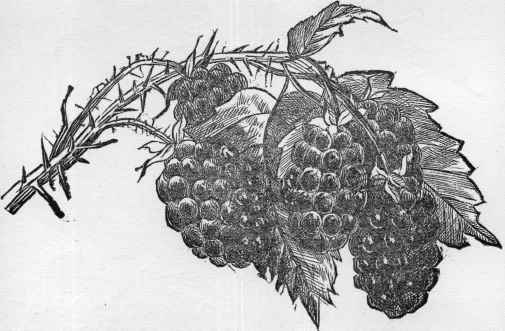
The Kittatinnv Blackberry.
The Kittatinny.— Despite Mr. Mitchell‘s elo
quence the Lawton is giving way to new and
better-liked varieties, prominent among which
is the Kittatinny. This is a native wildling in
troduced by Mr. Wolverton, who found it grow
ing in a forest near the Kittatinny Mountains,
Warren Co., N. J. It has become widely dis
seminated, and everywhere proves of the highest
value. Canes quite hardy, and very productive;
ripening early, and continuing a long time. Fruit
large to very large, roundish, conical, rich glossy
black, moderately firm, juicy, rich, sweet, ex
cellent. Roe says that Mr. Wolverton, in find
ing it, has done more for the world than if he
had discovered a gold-mine. Both this and the
Lawton belong to the R. Villosus species.
Wilson’s Early.—This belongs to the other spe
cies, the R. Canadensis. Introduced by John
Wilson, Burlington, N. J. A hardy, productive,
very early ripening sort. Fruit large, oblong
oval, black. Flesh firm, sweet, good. The fruit
is earlier than the Kittatinny, and tends to ripen
altogether in about ten days. Its flavor is infe
rior to that of the Kittatinny or Snyder, and it
is too tender for the North and West.
The Snyder.—This belongs to R. Villosus, ori
ginating near La Porte, Ia, about 1851, and is an
upright, exceedingly vigorous and stocky grower.
It is too small to compete with the already
described berries, yet Mr. Roe thinks “that on
moist land, with judicious pruning, it could be
made to approach them very nearly, however,
while its earliness, hardiness, fine flavor, and
124 ‘ THE FRIEND OF ALL.
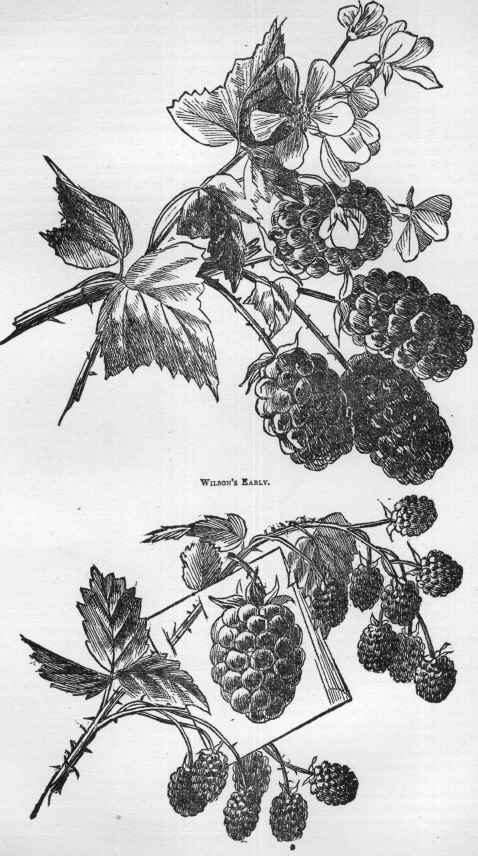
BERRIES. 125
ability to grow and yield abundantly almost any
where, will lead to an increasing popularity.
For home use, size is not so important as flavor
and the certainty of a crop. It is also more
nearly ripe when first black than any other kind
that I have seen ; its thorns are straight, and
therefore less vicious. I find that it is growing
steadily in favor; and where the Kittatinny is
winterkilled, this hardy new variety leaves little
cause for repining.”
Soil and Culture.—The blackberry does best on
light soils and in sunny exposures. The moist,
heavy, partially shaded land which is best for
the raspberry will send the growth of the black
berry into canes. The land should be warm
and well-drained, but not dry: as on hard dry
ground the fruit is liable not to mature, but
to become mere collections of seeds. Deep
plowing, and if possible following with the
lifting-plow to loosen the subsoil, as the roots
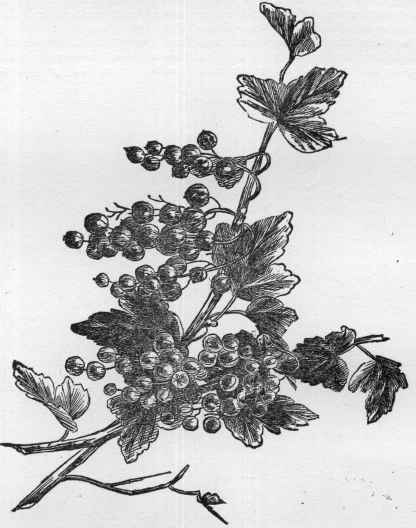
Red Dutch Currant.
require a large spread. Bushes should not be
allowed to grow over four feet high, and when
there is danger of winterkilling three feet is
enough, that the snow may cover and protect
them.
CURRANTS.
Professor Gray thus describes
“ Ribes Rubrum, Red Currant, cultivated from
Europe, also wild on our Northern border, with
straggling or reclining stems, somewhat heart-
shaped, three-to five-lobed leaves, the lobes
roundish and drooping racemes from lateral buds
distinct from the leaf-buds; edible berries red,
or a white variety.” The name is conjectured
to be a modification of Corinth, which once ex
ported so exclusively the small Zante grape.
Origin of our Cultivated Varieties. — These all
sprang from the imported varieties mentioned
above, or have been developed from wild speci-
126 THE FRIEND OF ALL.
mens found in the woods. Patience and perse
verance working with nature, have done won
ders.
Red Dutch.—This is an old, well-known sort,
thrifty, upright growth, very productive. Fruit
large, deep red, rich acid flavor, with clusters
two or three inches long. Of this Mr. Roe says :
“ It is the currant of memory. From it was
made the wine which our mothers and grand
mothers felt that they could offer with perfect
propriety to the minister. There are rural
homes today in which the impression still lin
gers that it is a kind of temperance drink.
From it is usually made the currant-jelly, with
out which no lady would think of keeping house
in the country. In flavor the Red Dutch is un-
equaled by any other red currant. It is also a
variety that can scarcely be killed by abuse and
Neglect, and it responds so generously to high
culture and vigorous pruning, that it is an open
question whether it cannot be made, after all,
the most profitable for market, since it is so
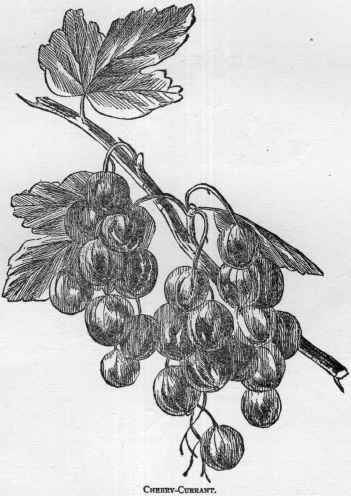
much more productive than the larger varieties,
and can be made to approach them so nearly in
size. Indeed, not a few are annually sold for
Cherry-currants.”
The White Dutch.—This is precisely similar to
the Red Dutch in habit, but the fruit is larger,
with rather shorter bunches, of a fine yellowish-
white color, with a very transparent skin. It is
considerably less acid than the red, and is there
fore much preferred for the table. It is also a
few days earlier. Very productive.
White Grape.—An advance in size of the White
Dutch. Bunches moderately long. berries very
large, whitish yellow, sweet and good. Very
productive. Branches more horizontal than
White Dutch, and less vigorous.
The Cherry-Currant.—This is the great market
currant. A strong-growing variety, with stout
erect, short jointed shoots. Leaves large, thick
and dark green. Not any more productive than
other currants, but a valuable one for market or
account of its size. Fruit of the very largest
BERRIES.
127
size. Bunches short. Berries deep red, and I
rather more acid than Red Dutch. The Cana
dian Horticulturist, September 1878, reads: “ The
history of this handsome currant is not without
interest. Mons. Adrienne Seneclause, a distin
guished horticulturist in France, received it from
Italy among a lot of other currants. He noticed
the extraordinary size of the fruit, and gave it, \
in consequence, the name it yet bears. In the
year 1843, it was fruited in the nursery of the
Museum of Natural History, and figured from
these samples in the Annales de Flore et de Po-
mone for February, 1848. Dr. William W. Valk,
of Flushing, Long Island, N. Y., introduced it to
the notice of American fruit-growers in 1846,
having imported some of the plants in the spring
of that year.”
The Versailles, La Versaillaise, so nearly resem
bles the cherry-currant, that the opinion is quite
general that the two are nearly or quite identical.
Mr. Downing finds a difference in the fact that
while the Versailles strain produces many short
bunches like the Cherry, it also frequently bears
long tapering clusters such as are never formed
on the Cherry. Mr. Roe has not been able to
verify even this distinction.
The Victoria, often called May’s Victoria, is a
very excellent, rather late sort, with very long
bunches of bright red fruit, and is an acquisition
to this class. Berries as large as Red Dutch.
Bunches rather longer, of a brighter red, growth
more slow, spreading, and very productive.
Will hang on the bushes some two weeks longer
than most currants.
Black Currants form a distinct class, not nearly
as popular here as in England. They are stronger
and coarser growing plants than the red and
white species, and do not demand as high culture.
There are several varieties grown here, but on a
limited scale: the. Bang Up, the Black Grape, the
Black Naples, the English Black, the Common
Black and Lees Prolific.
Choice and Preparation of Soil.—Mr. Roe says ;
“ The secret of success in the culture of currants
is suggested by the fact that nature has planted
nearly every species of the Ribes in cold, damp,
northern exposures. Throughout the woods
and bogs of the Northern Hemisphere is found
the scraggy, untamed, hardy stock from which
has been developed the superb White Grape.
Development does not eradicate constitutional
traits and tendencies. Beneath all is the craving
for primeval conditions of life, and the best success
with the currant and gooseberry will assuredly be
obtained by those who can give them a reasonable
approach to the soil, climate and culture suggested
by their damp, cold native haunts. The first requi
site is not wetness, but abundant and continuous
moisture. Soils naturally deficient in this, and
which cannot be made drought-resisting by deep
plowing and cultivation, are not adapted to the
currant. . . . Damp, heavy land, that is capable of
deep, thorough cultivation, should be selected if
possible. When such is not to be had, then, by
deep plowing, subsoiling, by abundant mulch
around the plants throughout the summer, and by
occasional waterings in the garden, counteracting
the effects of lightness and dryness of soil, skill
can go far in making good nature’s deficiencies.
“ Next to depth of soil and moisture, the cur
rant requires fertility. It is justly called one of
the ‘ gross feeders,’ and is not particular as to
the quality of its food, so that it is abundant. I
would still suggest, however, that it be fed ac
cording to its nature, with heavy composts, in
which muck, leaf-mold, and the cleanings of the
cow-stable, are largely present. Wood-ashes and
bone-meal are also most excellent.”
Planting.—Autumn is the best season for plant
ing currants, and early spring nearly as good.
There is little danger of the plants dying at any
time if kept moist. The young bushes should
be cut back after planting, half or two thirds.
If rows are five feet apart, and the plants fout
feet apart in the rows, an acre will hold 2178
plants. If set at right angles five feet apart, an
acre will hold 1742 plants. They ought to be
set about three inches deeper than they stood in
the nursery, and should have a shovel-full of com
post around each young plant. Mr. Roe recom
mends the bush and not the tree form when cur
rants are to be grown for market.
GOOSEBERRIES.
Description.—The gooseberry (Grossularid) is a
sub-genus of the genus Ribes, to which the currant
belongs, distinguished by a thorny stem, a more or
less bell-shaped calyx, and flowers on one-to-three
flowered stalks. The common gooseberry is a
native of many parts of Europe and northern
Asia, growing wild in rocky situations and in
thickets, particularly in mountainous districts.
The varieties produced by cultivation in England
are very numerous, where, and especially in Lan
caster, greater attention is paid to its cultivation
than in any other part of the world. The Lan
caster annual shows exhibit this fruit in its great
est perfection, and a Gooseberry Book is published
annually at Manchester, giving a list of prize
sorts, etc. More than a hundred and fifty exhi
bitions have been made in a single year, and the
berry, which in its wild state weighs only about
I one quarter of an ounce, and is a half-inch in
diameter, has been cultivated to a size of two
inches in diameter and the weight of an ounce
and a half. But the English climate, with its
moisture and coolness, seems especially fitted for
I the growth of this fruit, and under our clear and
128 THE FRIEND OF ALL.
hot suns the best varieties of English sorts do
not thrive, mildew of fruit and foliage being their
steady enemy. But on the other side, as Mr.
Downing writes, “ we are indebted to the Lan
cashire weavers, who seem to have taken it up
as a hobby, for nearly all the surprisingly large
sorts of modern date.”
Foreign Varieties.—As these cannot be depended
upon to flourish here, it will be enough merely to
give the names of a few leading varieties:—Red
Gooseberries: Boardman’s British Crown,
Champagne, Melting’s Crown Bob; Yellow
Gooseberries: Buerdsill’s Duckwing, Hill’s
Golden Gourd, Yellow Ball; Green Goose
berries: Colliers Jolly Angler, Green Walnut,
Wainman’s Green Ocean; White GOOSE
BERRIES: Crompton’s Sheba Queen, Saunders’
Cheshire Lass, Taylor‘s Bright Venus. (These
names, and many others, suggest the yearning of
the weavers to find the ideal in the actual.)
Seedlings of these foreign varieties have the
same tendency to mildew shown by their parents.
The Ribes Hirtellum is described by Prof. Gray
as the “ commonest in our Eastern States, seldom
downy, with very short thorns or none, very short
peduncles, stamens and two-cleft style scarcely
longer than the bell-shaped calyx; and the
smooth berry is purple, small and sweet.” This is
the parent of the most widely known of our native
varieties, first among which may be mentioned
The Houghton Seedling.—This originated with
Abel Houghton, Lynn, Mass. A vigorous grow
er ; branches rather drooping, slender, very pro-
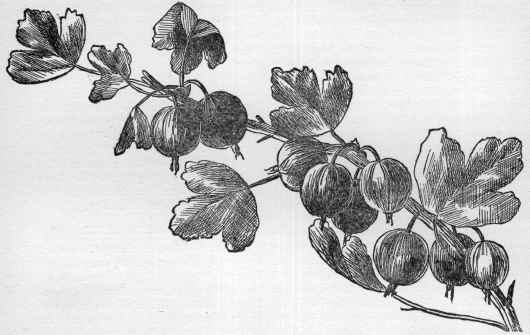
Houghton’s Seedling.
ductive, generally free from mildew; a desirable
sort. Fruit medium or below, roundish, inclin
ing to oval. Skin smooth, pale red. Flesh ten
der, sweet and very good. It improves greatly
under high culture and pruning.
The bush has a slender and even weeping
habit of growth, and can be propagated readily
by cuttings.
Downing.—This is a seedling of the Houghtom
originated by Mr. Charles Downing, of New-
burgh, N. Y. An upright, vigorous growing
plant, very productive. Fruit somewhat larger
than the Houghton, roundish oval, whitish green,
with the rib-veins distinct. Skin smooth. Flesh
rather soft, juicy, very good. Excellent for
family use. Mr. Roe says : “ I consider this the
best and most profitable variety that can be gen
erally grown in this country. In flavor it is ex
cellent. I have had good success with it when
ever I have given it fair culture. It does not
propagate readily from cuttings, and therefore I
increase it usually by layering.”
Smith’s Improved.—A new variety grown from
the seed of the Houghton by Dr. Smith, of Ver
mont, and in growth of plant more upright and
vigorous than its parent; the fruit is larger, and
somewhat oval in form, light green, with a
bloom. Flesh moderately firm, sweet and good.
Hobbs’ Seedling.—A variety said to have been
originated by O. J. Hobbs, of Randolph, Pa.
Light pale green, roundish, slightly oval, smooth.
Flesh medium firmness. A good keeper, and
nearly one half larger than Houghton‘s.
• BERRIES. 129
Mountain Seedling.—Originated with the Shakers
at Lebanon, N. Y. Plant a strong, straggling
grower, and an abundant bearer. Fruit large, the
largest of any known American sort, long oval,
dark brownish red, with long stalk. Skin smooth,
thick. Flesh sweet. A good market sort.
Pale Red.—A variety of unknown origin. Bush
more upright than Houghton. Slender wood.
Very productive. Fruit small or medium, about
the size of the Houghton ; darker in color when
fully ripe. Hangs a long time upon the bush.
Flesh tender, sweet, very good.
Chester, or American Red, is an old variety, whose
origin is unknown—probably its ancestors grew
wild in the woods. Fruit not quite as large as
the Houghton, when fully ripe darker than that,
hangs long on the bush, and is sweet and good.
Said not to mildew. Such characteristics point
it out as suitable for a parent of new varieties.
Cultivation.—Like its near relative the currant,
it flourishes best in cool exposures, and is the
better for partial shade. A rich soil, especially
one deep and moist, is equally requisite, and
vigorous annual pruning is essential. It is im
patient of drought, and needs a deep, strong
loam. Don‘t put it under other trees for the
sake of shade, as that deteriorates the fruit in
9
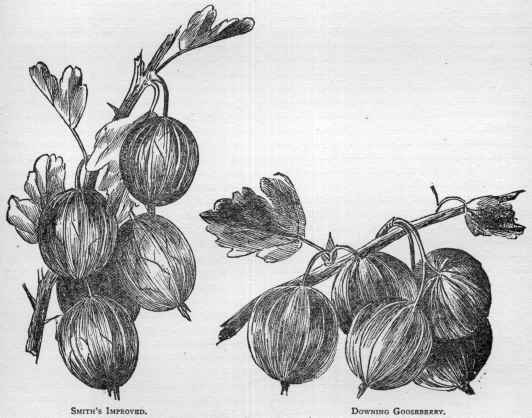
flavor and size, and, its vitality thus reduced, it
is more liable to mold. The plants should only
be raised from cuttings, unless the object be to
produce a new variety, which of course must be
raised from seed. The Encyclopœdia of Garden
ing thus describes the pains taken by Lancashire
cultivators : “ To effect this increased size, every
stimulant is applied that their ingenuity can sug
gest. They not only annually manure the soil
richly, but also surround the plants with trenches
of manure for the extremities of the roots to
strike into, and form around the stem of each
plant a basin, to be mulched, or manured, or
watered, as may become necessary, Whea a
root has extended too far from the stem, it is
uncovered, and all the strongest leaders are
shortened back nearly one half of their length,
and covered with fresh, marly loam, well ma
nured. The effect of this pruning is to increase
the number of fibers and spongioles, which form
rapidly on the shortened roots, and strike out in
all directions among the fresh, newly stirred
loam, in search of nutriment.”
In large plantations, and where cultivation is
given by means of the horse and plow, the sys
tem of growing in the bush form is by many
considered most profitable.
130
THE FRIEND OF ALL.
CRANBERRIES.
Description.—Downing says : This is a familiar
trailing shrub, growing wild in swampy, sandy
meadows, and mossy bogs, and produces a round
red, acid fruit. Our native species Oxycoccus
Macrocarpus, so common in the swamps of New
England, and on the borders of our inland lakes,
as to form quite an article of commerce, is much
the largest and finest species; the European
cranberry being much smaller in its growth, and
producing inferior fruit.
If Downing‘s description is not formal enough,
take this from the Encyclopaedia Britannica:
" O. palustris, the common cranberry plant, is
found in marshy land in northern and central
Europe and North America. Its stems are wiry,
creeping, and of varying length ; the leaves are
evergreen, dark and shining above, glaucous be
low, revolute at the margin, ovate, lanceolate or
elliptical in shape, and not more than half an inch
long; the flowers, which appear in May or June,
are small and pedunculate, and have a four-lobed,
rose-tinted corolla, purplish filaments, and an
ther-cell, forming two long tubes; the berries
ripen in August and September; they are pear-
shaped, and about the size of currants, are crim
son in color, and often spotted, and have an acid
and astringent taste.”
Of the 0. Macrocarpus, there are three varie
ties: the Bell-Shaped, which is the largest and
most valued, of a very dark, bright red color.
The Cherry, two kinds, large and small; the large
one the best, of a round form, a fine dark red berry,
nearly or quite equal to the Bell-shaped ; and the
Bugle, Oval, or Egg-Shaped, two kinds, large and
small, not so high-colored as the Bell and Cher
ry—not so much prized, but still a fine variety.
Cultivation.—Although, naturally, it grows most
ly in mossy, wet land, yet it may be easily culti
vated in beds of peat soil, made in any rather
moist situation ; and if a third of old thoroughly
decayed manure is added to the peat, the berries
will be much larger, and of more agreeable flavor
than the wild ones. A square of the size of
twenty feet, planted in this way, will yield three
or four bushels annually. The plants are easily
procured, and are generally taken up like squares
of sod or turf, and planted two or three feet
apart, when they quickly cover the whole beds.
Cape Cod Culture.—The Cranberry grows freely
in light soils, but the surface should be covered,
after plowing, with clean sand a depth of several
inches. Eighty to a hundred bushels to the acre
is an average product, and the care they require
after the land is once prepared and planted, is
next to nothing till they are ready to gather.
Some farms in Massachusetts bear large crops,
partly natural, partly cultivated. The berry grows
wild in the greatest abundance on the sandy low
necks near Barnstable, and an annual festival is
made of the gathering of the fruit, which is done
by the mass of the residents, who turn out on a
day appointed by the authorities, and make a
general gathering with their cranberry rakes, a
certain portion of the crop belonging and deliv
ered to the town. One man with his rake will
gather about thirty bushels a day. The rake,
however, is wasteful; and where cranberries are
grown on private property, and picked by hand,
three bushels is somewhere near the average
picking of a day.
Results.—Joseph J. White, in Cranberry Cul
ture, tells of a “ little pond “ in Burlington Co.,
N. J., containing twelve acres. After being
planted ten years at an original cost of not ex
ceeding $500, he saw a patch of vigorous vines,
from which the proprietor told him he never
gathered at one picking less than a bushel and
a half per square rod, and sometimes they
yielded two bushels. A square rod of the best
vines was staked off, and the berries carefully
picked. The yield was six bushels and two
quarts, or at the rate of 970 bushels to the acre.
Three acres of this meadow netted $1800 in one
year. Of course, this is an extreme case.
The Name is supposed to have been derived
from the appearance of the bud. Just before
expanding into the perfect flower, the stem,
calyx and petals resemble the neck, head and
bill of a crane ; and so cranberry may be a short
ening of craneberry.
Uses.—In addition to their value in the differ
ent forms of Cranberry Sauce, Cranberry Pie,
Preserved and Canned Cranberries, and the well-
known accompaniment to fowls, they are com
ing into use on shipboard as an antiscorbutic,
and in Europe a wine is made from them. White
tells of an Englishman, who receiving a barrel
of cranberries from a friend in America, ac
knowledged their receipt, stating that “the ber
ries arrived safely, but they soured on the pas
sage” leaving his American friend to infer that
I the uncooked fruit was served up in cream.
But first, if you want to come back to this web site again, just add it to your bookmarks or favorites now! Then you'll find it easy!
Also, please consider sharing our helpful website with your online friends.
BELOW ARE OUR OTHER HEALTH WEB SITES: |
Copyright © 2000-present Donald Urquhart. All Rights Reserved. All universal rights reserved. Designated trademarks and brands are the property of their respective owners. Use of this Web site constitutes acceptance of our legal disclaimer. | Contact Us | Privacy Policy | About Us |